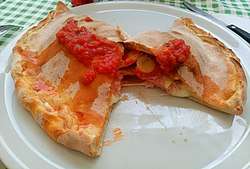Calzone
A calzone (UK: /kælˈtsoʊni, -neɪ/, US: /kælˈzoʊn, -zoʊneɪ, -ni/, Italian: [kalˈtsoːne]; "stocking" or "trouser")[1] is an Italian oven-baked turnover made with folded leavened dough.[2] It originated in Naples[3] in the 18th century[4] although, according to the Slow Food foundation, it was also produced in Basilicata around the same time.[5] A typical calzone is made from salted bread dough, baked in an oven and is stuffed with salami, ham or vegetables, mozzarella, ricotta and Parmesan or pecorino cheese, as well as an egg.[3] Different regional variations in or on a calzone can often include other ingredients that are normally associated with pizza toppings. The term usually applies to an oven-baked turnover rather than a fried pastry (i.e. panzerotti),[6] though calzoni and panzerotti are often mistaken for each other.[6][7][8][9]
 Simple calzone in an Italian pizzeria, cut in half | |
| Type | Turnover |
|---|---|
| Place of origin | Italy |
| Region or state | Apulia, Abruzzo, Basilicata, Campania, Calabria, Sicily, Sardegna |
| Main ingredients | Ricotta, mozzarella, salami/ham, parmesan/pecorino |
| Variations | Tomato, provolone, anchovies, olives, onions, chards, minced meat, fish, cabbage |
| Part of a series on |
| Pizza |
|---|
.jpg) |
|
Pizza varieties
|
|
Cooking variations
|
|
Pizza tools
|
A calzone is somewhat similar to a stromboli. A calzone is a baked turnover stuffed with pizza ingredients. A stromboli is usually made by rolling up dough with cheese and meat ingredients and is then baked, but it does not generally contain pizza ingredients aside from cheese and Italian meats. Generally, strombolis do not usually contain tomato sauce, unlike calzones. A calzone is crescent-shaped, and a stromboli is usually shaped like a long cylinder. The distinction between the two is complicated because there is some variation in what constitutes a stromboli.[10][11][12]
Regional variations
In Italy
Sandwich-sized calzones are often sold at Italian lunch counters or by street vendors, because they are easy to eat while standing up or walking.[13] Fried versions of the calzone are typically filled with tomato and mozzarella: these are made in Apulia and are called panzerotti.[14]
In Basilicata, a variety of calzone is known as pastizz, which originated between the 18th and 19th century.[5] Pork (or, more rarely, goat meat), eggs and cheese are main ingredients for the filling.
The Sicilian cuddiruni or cudduruni pizza is distantly related to the calzone. This is a dish stuffed with onions (or sometimes other vegetables, such as potatoes or broccoli), anchovies, olives, cheese and mortadella; the rolled pizza dough is folded in two over the stuffing and the edges are sealed before the dish is fried.
In the United States
In the United States, calzones are typically made from pizza dough and stuffed with meats, cheeses, and vegetables.
Traditional calzone dough, consisting of flour, yeast, olive oil, water, and salt, is kneaded and rolled into medium-sized disks. Each is then filled with cheeses such as ricotta, mozzarella, Parmesan, provolone, and other traditional vegetables or meats. The dough is then folded in half over the filling and sealed with an egg mixture in a half-moon shape, or is sometimes shaped into a ball by pinching and sealing all the edges at the top. It is then either baked or fried.
In some areas, just before serving, they are topped with marinara or other traditional sauce, or with a mixture of garlic, olive oil, and parsley.
Cultural notes
In Italy, as of the 1960s, calzones were popularly believed to be the most efficient type of pizza for home delivery.[15]
See also
References
- "dictionary.com". Dictionary.reference.com. Retrieved 2012-11-07.
- "calzone | Jamie Oliver | Food | Recipes (UK)". Jamie Oliver. Retrieved 2012-11-07.
- Gosetti (1967), p.785
- "History". The CalZone Zone.
- "U' Pastizz 'Rtunnar Calzone". fondazioneslowfood.com. Retrieved July 26, 2020.
- "La vera ricetta dei panzerotti pugliesi". Gustoblog.it. 2009-03-03. Retrieved 2015-12-05.
- Sarkar, Suhashini (June 29, 2015). "Panzerotti: The Empanada’s Italian Cousin", Saveur. Retrieved February 13, 2016.
- Minchilli, Elizabeth (December 11, 2014). "Making Panzerotti in Barivecchia", Elizabeth Minchilli in Rome. Retrieved February 13, 2016.
- "Deep Fried Panzerotti", food.com. Retrieved February 13, 2016.
- Shuster, Jim (May 10, 2012). "The Stromboli vs. the Calzone", Gilroy Patch. Retrieved August 14, 2016.
- Daley, Bill (March 26, 2013). "Calzone v. Stromboli". Chicago Tribune. Retrieved March 29, 2013.
- Vadala, Nick (June 17, 2014). "The Stromboli: A Philly Original, Courtesy of Romano's". Philly.com. Retrieved April 16, 2016.
- MacKenzie, Shea (1995). The Pizza Gourmet. Garden City Park, N.Y.: Avery Pub. Group. pp. Preface iv. ISBN 089529656X.
- Annamaria Settanni McDonald. "Puglia panzarotti". Justapinch.com. Retrieved 2012-11-07.
- Gosetti (1967), p.787
Bibliography
| Wikimedia Commons has media related to Calzone. |
| Look up calzone in Wiktionary, the free dictionary. |
- Gosetti Della Salda, Anna (1967). Le ricette regionali italiane (in Italian). Milano: Solares.
